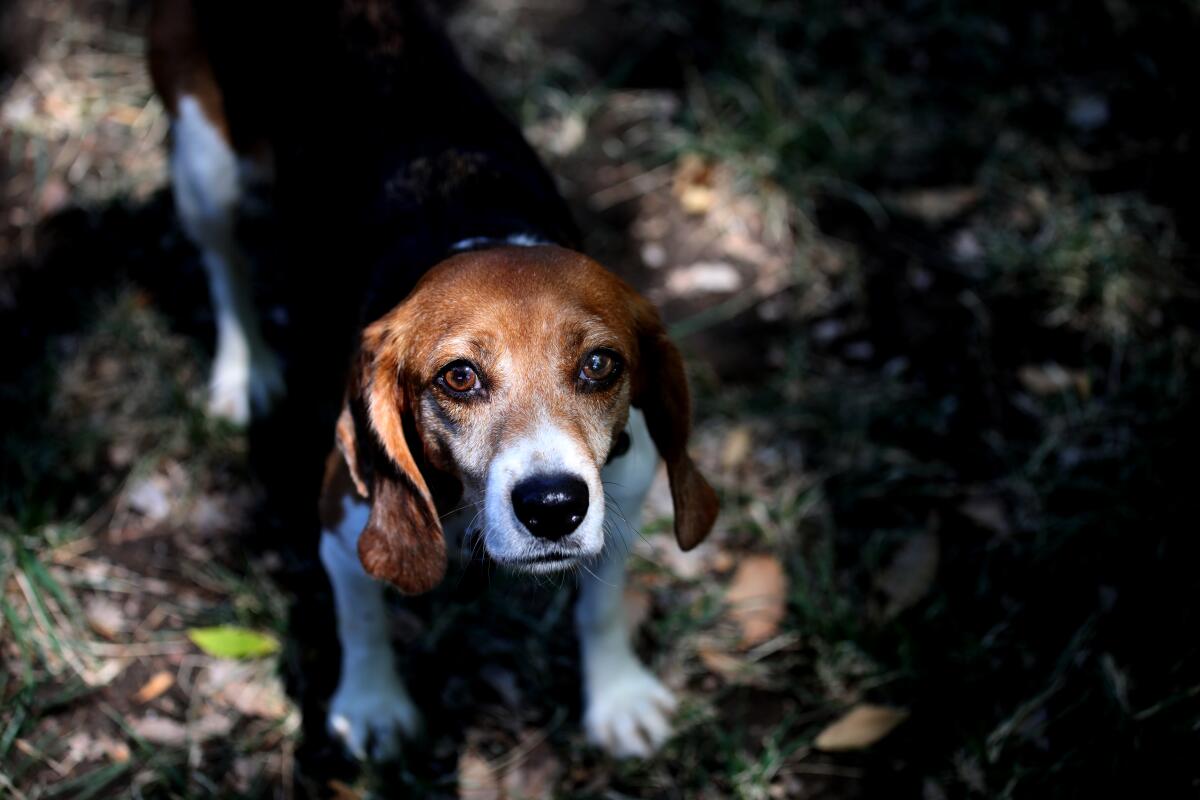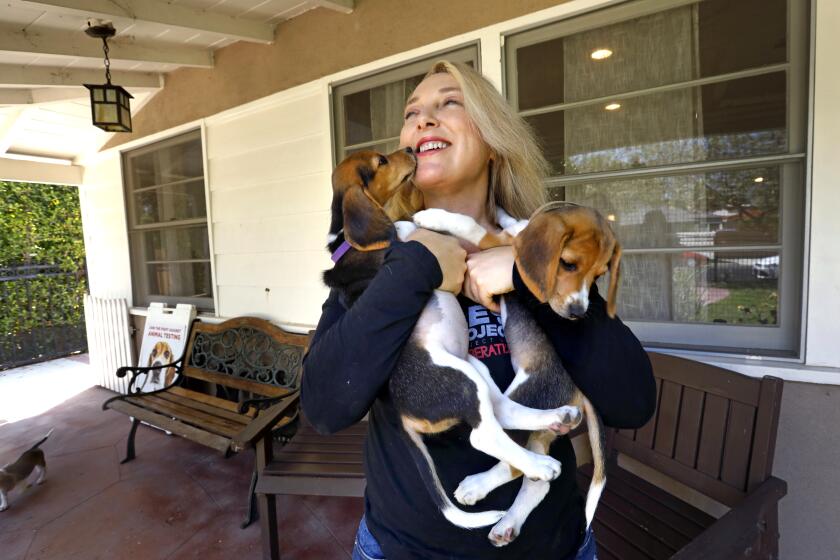4,000 abused beagles were liberated from captivity. One found a home in Sherman Oaks

- Share via
You would hardly guess that for most of her 5½ years, Nancy was kept in a cage at a notorious Virginia beagle breeding facility owned by Envigo, producing litter after litter of puppies destined for research laboratories around the country.
Why, after the way she’s been treated, is she so sweet?
When I met Nancy on Monday morning, she was curled up on a blue couch at home in Sherman Oaks with her new people, Gary Smith and Kezia Jauron. A beautiful, slender beagle with the sad round eyes so typical of the breed, Nancy came right to me, sniffing and gently licking.
Early this month, Nancy was liberated from doggie hell, thanks to a lawsuit filed against Envigo by the Department of Justice for multiple violations of the Animal Welfare Act.
Department of Agriculture inspectors documented grotesque conditions resulting in needless suffering and death at the Envigo facility in Cumberland, Va. Their photos showed beagles in advanced stages of dental disease, eyes dripping with pus, in overcrowded and filthy cages. The food supply was infested with maggots. A 3-week-old puppy was trapped on its back in the feces-filled space beneath the wire floor of its cage.
As part of its settlement agreement, Envigo agreed to give about 4,000 beagles to the Humane Society of the United States. The Humane Society, in turn, is placing the dogs with dozens of rescue groups around the country and is finding foster homes for the pups.
The Duke and Duchess of Sussex choose a 7-year-old female named Mamma Mia, who was used as a breeder at the animal-testing facility.
On Aug. 2, Nancy and 14 others arrived at Cage to Couch, an Anaheim-based rescue founded by Mary Pryor, an animal lover who owns three rescue beagles — two blinded by experiments and one “seizure beagle” who was used in epilepsy treatment research. Pryor hopes to receive about 20 more Envigo beagles.
Nancy, whose ears were torn and scabbed, was spayed and treated with antibiotics. Pryor placed her with Smith and Jauron, longtime vegans and animal rights activists who own a public relations firm that represents clients with similar values.
Nancy joined a family of rescues that includes Josephine, another beagle who was saved five years ago in China when the truck she was in en route to the infamous Yulin dog meat festival was forced off the road by animal rights activists, and Gideon, an African gray parrot given to ear-piercing shrieks that sound like an especially loud but dying smoke detector.
“I can’t have a dog unless they have a terrible, terrible story,” said Jauron.
Nancy is settling in. She loves her squeaky llama toy and has just started to show excitement about breakfast and dinner. So far, she’s not happy on a leash, and loud noises freak her out. In her new backyard, shaded by a massive ash tree, she gingerly sniffs and strikes a pose like a show dog for a Times photographer.
The Humane Society estimates that more than 60,000 dogs are experimented on in American laboratories each year. Last year, labs reported having 43,685 dogs in their possession. About 3,000 dogs were either kept by labs for breeding, like Nancy, or weren’t used at all.
Once the dogs are sent to research labs, they are operated on, implanted with medical devices or subjected to all kinds of toxicity tests: pesticides, insect repellent, rat poison. Typically, the Humane Society says, dogs are killed after an experiment ends, sometimes so their tissue and organs can be examined and sometimes because they are not useful anymore.
And, sometimes, they die because it’s cheaper than keeping them alive. (California is one of 11 states that require research dogs to be put up for adoption when experiments end.)
“The first rescues we were part of,” said Smith, “were dogs we got from a university. They were going to be shutting down for Christmas break. So, they were literally going to kill the dogs rather than pay people to go in and feed them and clean their cages for two weeks. It’s cheaper for them to basically just kill them and buy another one.”
The industry, understandably given the emotions around animal research, operates secretively.
“The opacity is really astonishing,” said Jauron. “I think there has to be such a level of depersonalization to be able to treat a dog no better than a test tube.”
::
For a lot of us, the ethics of using animals to improve human lives is fraught. It’s much easier to accept the practice when you don’t have to look into the eyes of a sentient creature like Nancy. But when you see photos of the horrendous conditions at Envigo’s facility, it’s even harder to stomach the reality. Is research on animals really necessary?
“Nothing so far has been discovered that can be a substitute for the complex functions of a living, breathing, whole-organ system with pulmonary and circulatory structures like those in humans,” says a Stanford University website about its use of animals in labs. “Our researchers are strong supporters of animal welfare and view their work with animals in biomedical research as a privilege.”
I don’t know that it’s ethically possible to square that circle. Can there be anything humane about causing animals to suffer, even if it’s for the good of humanity?
Before he died, I promised my father that I would care for Inky, his cat, no matter what. It hasn’t been easy. I had no idea she would wreck my home.
Smith pointed me to the work of Aysha Akhtar, a leading animal ethicist, neurologist and public health specialist, who argues in a recent journal paper that “a growing body of scientific literature undermines the validity of animal experimentation generally (and animal modeling specifically).” The results of animal experiments, she writes, do not reliably apply to human beings.
Resources, writes Akhtar, “would be better invested in developing human-based testing methods.”
To resolve the case of the mistreated beagles, Envigo, a subsidiary of Inotiv, admitted no liability and paid exactly zero in fines. (Inotiv, a research company servicing the pharmaceutical, chemical and medical device industries, was recently sued by a shareholder who claimed the company’s acquisition of Envigo in fall 2021 misled and damaged shareholders.)
Dog rescue groups were left footing the bill for transportation, food and veterinary costs for the thousands of rescued dogs.
And in all the Envigo beagle news coverage I’ve read, not a single human being has been named as a responsible party, which I find outrageous. Who, exactly, allowed this inhumane treatment, and why aren’t they being made to pay?
“It’s like Envigo got to trash the hotel room,” said Jauron, “and hand the bill to someone else.”
More to Read
A cure for the common opinion
Get thought-provoking perspectives with our weekly newsletter.
You may occasionally receive promotional content from the Los Angeles Times.













